Go is a top choice for REST API development due to its speed, simplicity, and built-in concurrency. The framework you pick can shape your API's performance, scalability, and ease of development. Here’s a quick rundown of the 10 best Go frameworks for REST APIs:
- Gin: Lightweight and fast, ideal for high-performance APIs.
- Echo: Combines speed with flexibility, supports advanced middleware.
- Fiber: Inspired by Express.js, great for developers transitioning from Node.js.
- Beego: Full-stack framework with built-in tools for enterprise-level apps.
- Chi: Minimalist router, perfect for microservices and modular APIs.
- FastHTTP: Unmatched raw speed, suited for high-throughput systems.
- Gorilla: Modular toolkit for custom routing and middleware.
- Buffalo: Full-stack framework for rapid API and web app development.
- Hertz: High-performance framework tailored for cloud-native systems.
- Flamingo: Enterprise-focused, modular, and built for complex systems.
Quick Comparison#
| Framework | Performance Level | Middleware Support | Integration Ease | Best For |
|---|---|---|---|---|
| Gin | High (40x faster than Martini) | Comprehensive | Easy | Microservices, lightweight APIs |
| Echo | High performance, low memory | Advanced middleware options | Moderate | Scalable APIs, performance-critical |
| Fiber | Very high (Express.js-like) | Rich middleware ecosystem | Easy (Node.js-like syntax) | High-performance APIs, microservices |
| Beego | Moderate (full-stack focus) | Built-in enterprise features | Complex | Enterprise apps, full-stack projects |
| Chi | High (lightweight router) | Flexible middleware chaining | Simple | Modular APIs, microservices |
| FastHTTP | Extremely high | Custom middleware required | Difficult | High-throughput APIs, custom servers |
| Gorilla | Moderate (modular approach) | Powerful WebSocket support | Flexible | Custom routing, scalable APIs |
| Buffalo | Moderate (full-stack) | Opinionated middleware stack | Easy | Rapid prototyping, full-stack apps |
| Hertz | Extremely high | Microservice-focused | Specialized | Cloud-native, high-concurrency APIs |
| Flamingo | Moderate (enterprise-focused) | Enterprise-grade features | Complex | Enterprise systems, modular APIs |
No matter your project’s scale or complexity, this list has a framework tailored to your needs. Start with a lightweight option like Gin or Fiber for speed, or go full-stack with Beego or Buffalo for enterprise features. Dive deeper into the article for a detailed breakdown of each framework.
1. Gin#
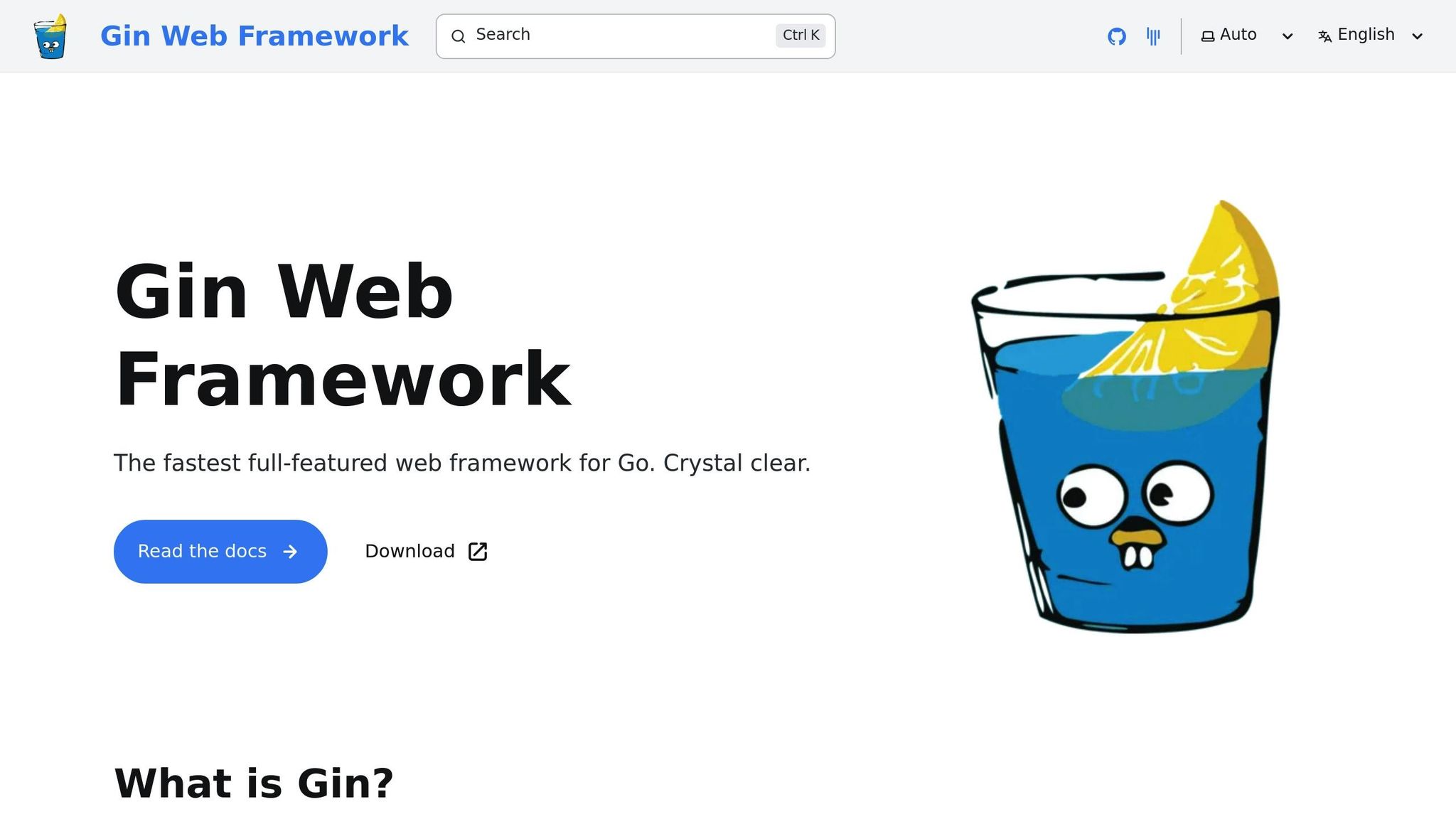
Gin has become a favorite among Go developers for building REST APIs, boasting over 68,000 stars on GitHub. This lightweight framework is known for its speed, simplicity, and efficiency.
Performance and Speed#
Gin is designed for speed. According to GitHub, it’s 40 times faster than
Martini, thanks to its use of a radix tree-based httprouter. By avoiding
reflection, Gin minimizes overhead, resulting in faster response times and
reduced memory usage. Its small footprint makes it ideal for applications where
performance is critical.
Middleware and Extensibility#
Gin comes with built-in middleware for essential features like JWT authentication, logging, rate limiting, and validation. It also supports unlimited nested route groups without compromising speed or performance. This flexibility allows developers to customize and extend their applications with ease.
Seamless Integration with Go#
One of Gin’s strengths is how well it integrates with the Go ecosystem. It’s
fully compatible with Go’s standard net/http library, making it easy for
developers to work with familiar tools. Database interactions are also
simplified through support for ORMs like Gorm.
Best Fit for REST API Development#
Gin shines in scenarios like microservices, high-performance web apps, and cloud-native systems. Leveraging Go's concurrency model, it can handle thousands of requests per second while maintaining low latency. Up next, we’ll dive into Echo, another framework celebrated for its flexibility in API development.
2. Echo#
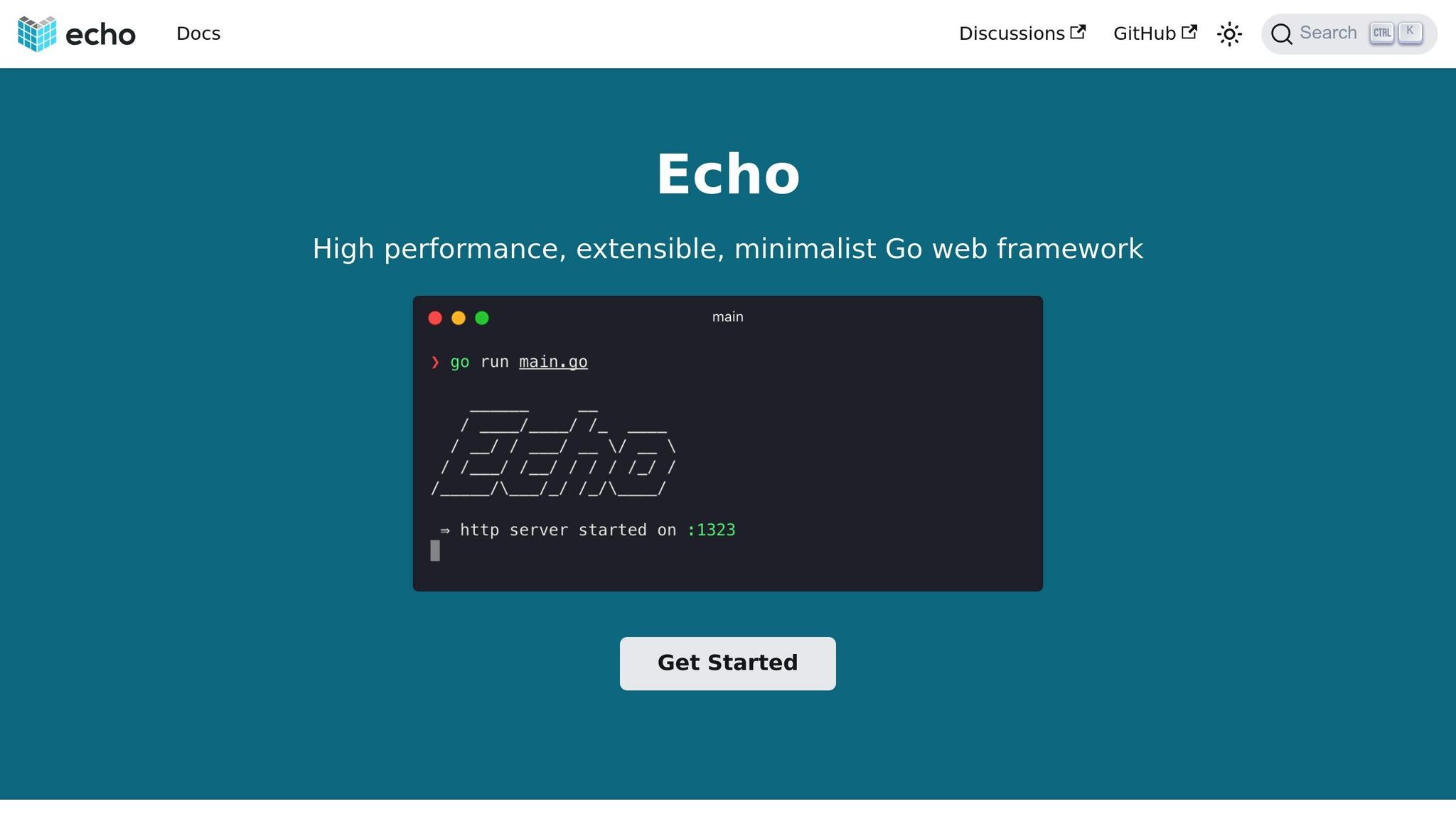
Echo is a Go web framework that takes a minimalist approach while offering a blend of speed and flexibility. It's carved out a solid reputation in REST API development, appealing to developers who need both performance and the ability to customize heavily. Unlike Gin, which focuses purely on speed, Echo provides a middle ground, making it a go-to choice for projects requiring advanced middleware and routing options.
Performance and Speed#
Echo's HTTP router is designed for efficiency. By avoiding dynamic memory allocation and prioritizing routes, it processes requests quickly and ensures fast responses. It also supports HTTP/2 out of the box, which speeds up modern web communications. These design decisions minimize overhead while maintaining impressive performance in handling HTTP requests.
Middleware Support and Extensibility#
One of Echo’s standout features is its robust middleware system. It offers a wide range of built-in middleware functions to enhance functionality and security. Middleware can be applied globally, to specific route groups, or even to individual routes, giving developers fine-grained control. For unique needs, developers can also create custom middleware, making it easy to handle tasks like authentication or centralized error handling.
Seamless Integration with the Go Ecosystem#
Echo works effortlessly with Go’s ecosystem, making it simple to integrate custom components or third-party tools. This adaptability allows developers to tailor the framework to their specific project needs, all while staying compatible with Go's standard libraries.
Best Fit for REST API Development#
Echo shines when it comes to building scalable and high-performance REST APIs. It’s particularly effective for complex web applications that require advanced routing and can handle a high volume of requests efficiently. With its flexibility to implement custom business logic through middleware, Echo is a strong contender for enterprise-level REST APIs that demand both speed and sophisticated request processing.
Next, we’ll take a look at Fiber, a framework inspired by Express.js, and how it fits into the Go development landscape.
3. Fiber#

Fiber brings an Express.js-inspired syntax to Go development, making it a popular choice for developers transitioning from Node.js or those looking for a simpler API design. Built on top of Fasthttp - widely recognized as the fastest HTTP engine for Go - Fiber combines speed with user-friendly features. Its design philosophy leans heavily on minimalism and the Unix principle of creating modular and straightforward tools.
Performance and Speed#
Thanks to its zero allocation design powered by Fasthttp, Fiber delivers impressive performance with high requests per second (RPS) and low memory usage. However, benchmarks suggest it may experience reduced throughput under heavy concurrency. This lightweight approach ensures applications remain responsive, particularly in scenarios where memory efficiency is crucial.
Middleware Support and Extensibility#
Fiber boasts a rich middleware ecosystem, making it highly extensible. Using
app.Use(), developers can access the fiber.Ctx object, enabling them to
modify requests and responses effortlessly. The framework supports both internal
and external middleware, offering flexibility for a wide range of use cases.
In June 2024, Fiber introduced an upgrade to its compression middleware with support for zstd compression. This update allows for better bandwidth management and faster load times, especially for applications that benefit from higher compression ratios.
Fiber also comes with a comprehensive suite of built-in middleware options:
| Category | Middleware Examples | Purpose |
|---|---|---|
| Security | basicauth, cors, csrf, helmet | Authentication and protection |
| Performance | cache, compress, limiter | Optimization and rate limiting |
| Utilities | logger, requestid, recover | Debugging and error handling |
| Static Content | static, favicon | File serving |
This middleware setup integrates seamlessly with Go's broader ecosystem, allowing developers to extend functionality with ease.
Integration with the Go Ecosystem#
Fiber's API, inspired by Express.js, makes it particularly approachable for
developers with a JavaScript background while maintaining full compatibility
with Go's ecosystem. For example, Fiber includes an adaptor middleware that
converts net/http handlers to and from Fiber request handlers. This feature
ensures smooth integration with existing Go libraries and tools.
Best Use Cases for REST API Development#
Fiber shines in several contexts when it comes to REST API development. For instance, Uber has adopted Fiber as its framework of choice for building microservices in Go. Other notable companies using Fiber include Carbon, which relies on Fiber for its decentralized social network backend, Alasco for managing construction costs, and KubeSphere for backend services in a multi-tenant Kubernetes platform.
Fiber is particularly well-suited for:
- Microservices architectures, thanks to its lightweight and scalable nature.
- Single-page applications (SPAs), leveraging its robust template and middleware capabilities.
- High-performance web applications, where speed and efficient memory usage are critical.
Its design simplifies data handling, making it an excellent option for building REST APIs in Go. Additionally, the Express.js-inspired syntax reduces the learning curve for developers familiar with JavaScript frameworks.
Next, we’ll explore Beego, which offers a more full-stack approach compared to Fiber’s lightweight design.
4. Beego#
Beego is a full-stack Go web framework that follows the Model-View-Controller (MVC) design pattern. It provides developers with a complete toolkit right out of the box, making it a go-to choice for enterprise-level applications that prioritize convention over configuration.
One of Beego's standout features is its automatic RESTful routing, which reduces repetitive code and improves the maintainability of APIs. This, combined with its scalability and ease of use, has attracted major companies like IBM. Its strong community support and comprehensive feature set make it a reliable option for developers.
Performance and Speed#
While Beego performs well, its full-stack nature introduces some overhead compared to more lightweight frameworks. This trade-off means it doesn't deliver the same raw speed as frameworks like Fiber or FastHTTP, but it compensates with a well-rounded feature set that supports complex applications.
| Framework | Performance (RPS/Memory) |
|---|---|
| Beego | Moderate (full-stack) |
| Gin | High (excellent RPS, low memory) |
| Fiber | Very high (superior RPS, low memory) |
| FastHTTP | Extremely high (raw performance focus) |
Beego's modular design and MVC structure are particularly beneficial for enterprise applications, where organization and maintainability are key. However, for projects that require handling extremely high traffic - like over 100,000 requests per second - FastHTTP is a better fit.
Middleware Support and Extensibility#
Beego includes robust middleware capabilities, offering built-in support for tasks like authentication, security, rate limiting, and Cross-Origin Resource Sharing (CORS). Its flexible filter system allows developers to integrate middleware for JWT, OAuth, API key authentication, and more.
Integration with the Go Ecosystem#
Beego seamlessly integrates with Go's native features, leveraging interfaces and struct embedding to simplify development. Its built-in tools, such as an ORM, session management, and middleware support, reduce the need for external libraries, making it easier to build complex applications.
Best Use Cases for REST API Development#
Beego is particularly effective for:
- Enterprise-level applications that need a structured, feature-rich framework.
- RESTful API development, where its built-in tools simplify and speed up the process.
- Backend services requiring strong session management and database integration.
- APIs with versioning, ensuring backward compatibility as systems evolve.
With its automatic RESTful routing, robust middleware options, and straightforward handling of JSON/XML responses, Beego is a strong choice for building scalable REST APIs efficiently.
Next, let's explore how Chi provides a lightweight solution for routing and HTTP service composition.
5. Chi#
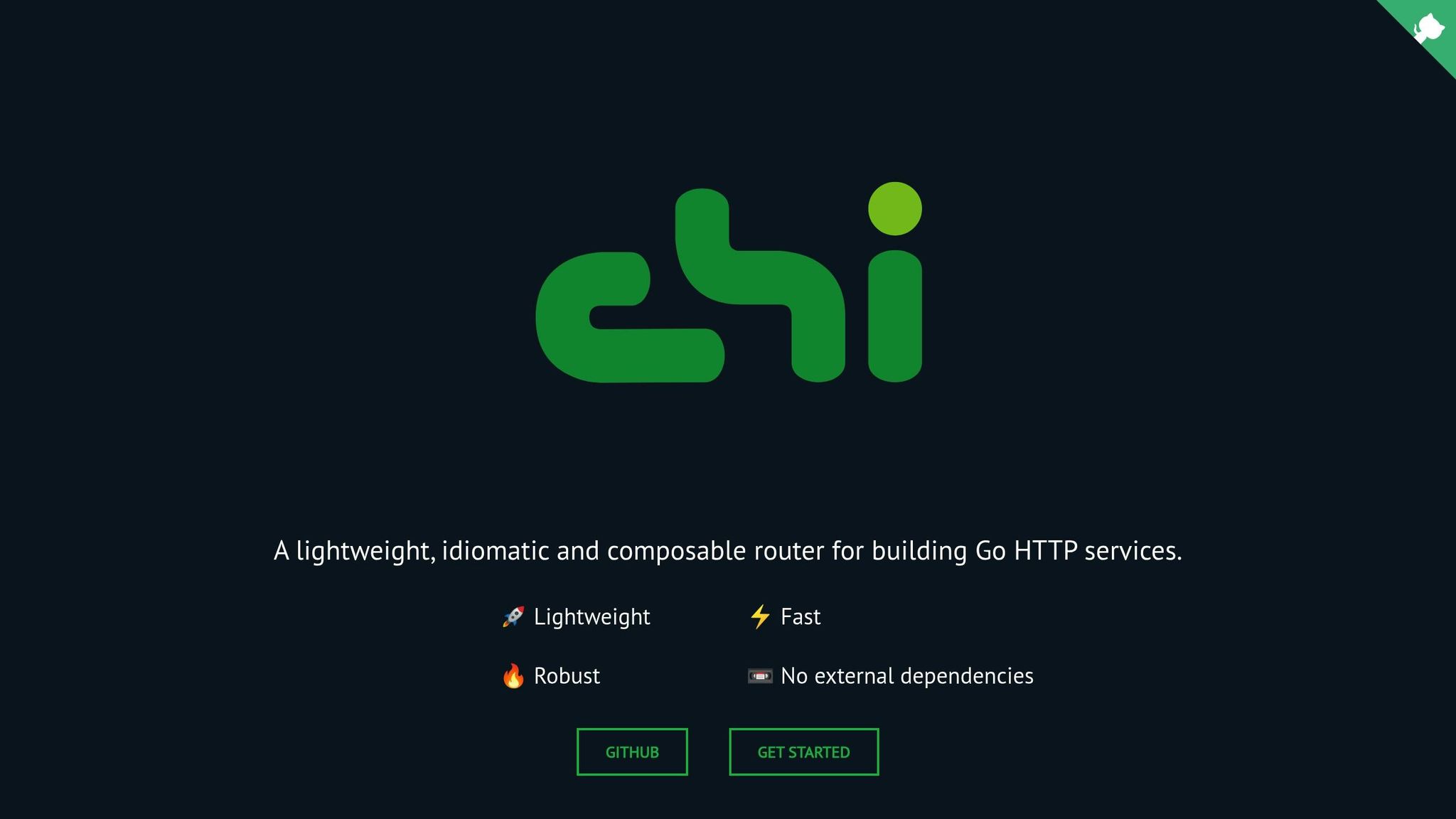
Chi is a lightweight router designed for building Go HTTP services with
simplicity and flexibility in mind. It closely aligns with Go's standard
net/http library, making it a breeze for developers familiar with Go to pick
up and integrate into their projects. This compatibility ensures a smooth
experience when working with existing HTTP middleware.
Performance and Speed#
Chi performs well thanks to its efficient tree-based routing system, which quickly matches requests. While it might not rival the raw speed of some high-performance frameworks, it strikes a solid balance between ease of use and resource efficiency. Its lightweight design keeps memory usage low, making it a great choice for applications that need to handle heavy traffic without hogging system resources. Developers can further fine-tune performance by carefully selecting middleware and ensuring proper resource management.
Middleware Support and Integration#
Chi's middleware operates as standard net/http handlers, ensuring seamless
compatibility with most middleware available in the Go ecosystem. It also comes
with a variety of built-in middleware for tasks like authentication,
compression, logging, rate limiting, and CORS. Its modular approach to API
design - using route groups and sub-routers - helps developers build clean,
maintainable systems. By leveraging Go's context package, Chi efficiently
handles features like timeouts, cancellations, and request-scoped data, making
it easier to chain middleware and manage complex workflows.
Ideal Use Cases for REST API Development#
Chi shines in microservices, where simplicity and modularity are key. It’s particularly appealing for teams that prefer working with Go's native libraries instead of diving into framework-specific abstractions. Its modular routing design allows different parts of a REST API to use distinct middleware stacks or routing rules. This makes it easier to independently develop and maintain separate sections of an API.
If raw performance for high-throughput scenarios is your priority, you might want to check out FastHTTP next.
6. FastHTTP#
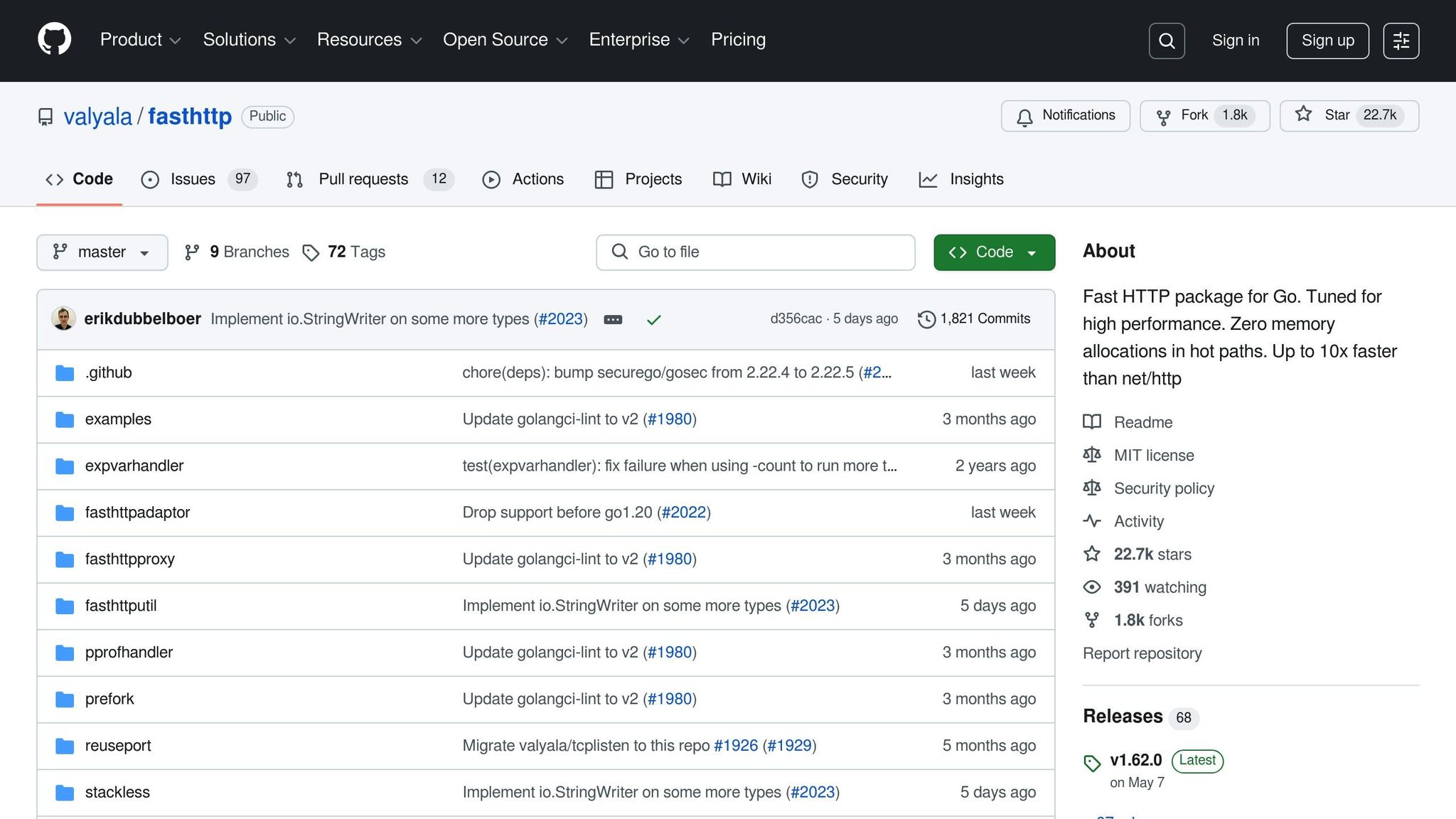
When your project demands top-tier speed and efficiency, FastHTTP is a
framework worth considering. Unlike most frameworks that rely on Go's standard
net/http package, FastHTTP builds its own HTTP server and client to deliver
unmatched performance. However, this comes with trade-offs in terms of ease of
use and general-purpose flexibility.
Performance and Speed#
FastHTTP is a powerhouse when it comes to raw performance. It can handle over
100,000 requests per second and manage more than 1 million active
connections at once. This is made possible by its use of a specialized
RequestCtx object, which minimizes memory allocations by reusing objects for
incoming requests. This design significantly reduces garbage collection
overhead, allowing for smoother operation. For instance,
VertaMedia
has reported serving up to 200,000 requests per second with 1.5 million
concurrent keep-alive connections on a single server.
Middleware Support and Extensibility#
FastHTTP takes a different approach to middleware. Unlike frameworks with
built-in middleware support, it uses Go's composable function model. Middleware
in FastHTTP is essentially a function that accepts a fasthttp.RequestHandler
and returns a modified fasthttp.RequestHandler. This gives developers the
flexibility to chain functions into a processing pipeline. However, this
flexibility comes at a cost: developers must either build custom middleware or
rely on third-party packages to implement structured solutions.
Integration Challenges with the Go Ecosystem#
FastHTTP's departure from the standard net/http package introduces some
integration hurdles. Many Go libraries and middleware are built around
net/http, so using them with FastHTTP often requires adapters or
FastHTTP-specific versions. Additionally, the fasthttp.RequestHandler
functions differ from the standard Handler interfaces, which can lead to a
steeper learning curve and potential compatibility issues.
Best Fit for REST API Development#
FastHTTP shines in scenarios where high performance is non-negotiable. It's particularly well-suited for use cases like gaming backends, financial platforms, or IoT endpoints - essentially, any system that needs to process thousands of small to medium requests per second with ultra-low response times. However, for typical REST APIs serving web or mobile applications, the complexity and integration challenges of FastHTTP may outweigh its benefits.
If you're looking for a framework that balances performance with ease of development, check out how Gorilla tackles these challenges.
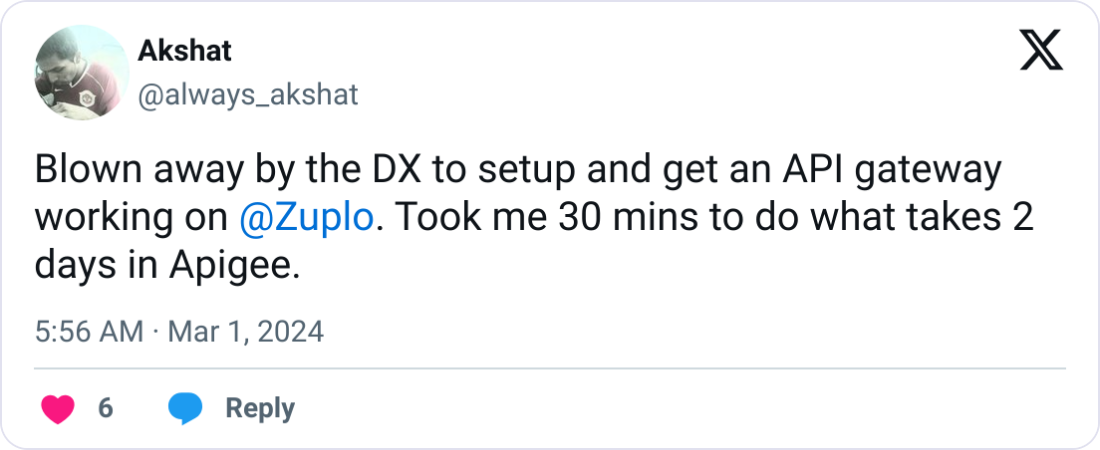
Over 10,000 developers trust Zuplo to secure, document, and monetize their APIs
Learn More7. Gorilla#

Gorilla is a set of modular packages designed to help developers create a custom toolkit tailored to their needs. Instead of relying on a single, all-in-one framework, Gorilla lets you pick and choose the components you want, avoiding unnecessary features and keeping your project lightweight.
Middleware Support and Flexibility#
One of Gorilla's biggest strengths is its modularity. For example, the Gorilla Handlers package offers middleware options for tasks like logging, authentication, and CSRF protection. You can combine this with other components like Gorilla Sessions for session management, Gorilla WebSocket for real-time communication, or Gorilla Schema for decoding forms - all within the same application.
At the core of many REST API implementations is the Gorilla Mux router. It provides advanced features like subrouters, which allow you to organize routes under shared prefixes. This is especially useful for structuring complex APIs, such as those with multiple versions or distinct functional areas.
Seamless Integration with Go's Ecosystem#
Gorilla stands out for how well it integrates with Go's ecosystem. Since
Gorilla Mux implements the http.Handler interface, it works seamlessly
with Go’s built-in net/http package and the standard http.ServeMux.
"Package gorilla/mux implements a request router and dispatcher for matching incoming requests to their respective handler." - Gorilla/mux documentation
This compatibility extends to widely used Go libraries like GORM, a popular ORM for database management. Developers can easily use GORM alongside Gorilla without running into integration issues. By sticking to Go's standard interfaces, Gorilla ensures that most third-party packages function without extra effort.
Best Fit for REST API Development#
Gorilla is perfect for developers building REST APIs that require structured routing and customizable middleware without the burden of a heavy framework. It’s particularly suited for scalable, maintainable APIs that handle a high volume of HTTP requests. Whether you’re implementing logging, authentication, or custom request processing, Gorilla’s modular design makes it easy to mix and match the middleware you need. Its support for defining routes for different HTTP methods (like GET, POST, PUT, DELETE) in a clean and organized way makes it a go-to choice for RESTful API development.
While Gorilla might take a bit more effort to set up compared to frameworks with built-in features, this initial investment pays off in the long run. Its modular nature ensures you’re not locked into a specific framework, giving you full control over your application’s architecture. If scalability and maintainability are priorities for your team, Gorilla is a solid option for building robust REST APIs.
8. Buffalo#
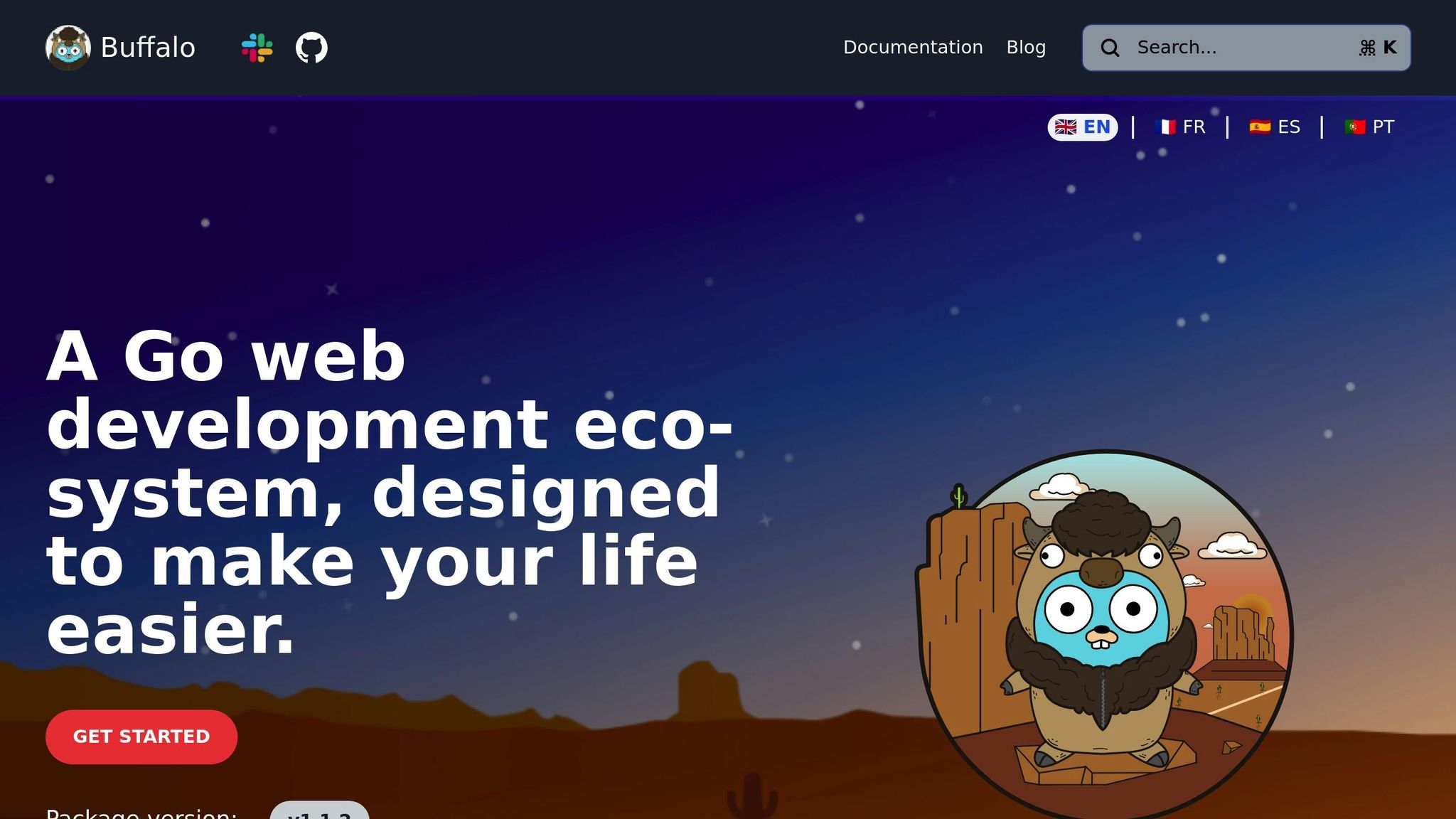
Buffalo is a full-stack framework written in Go, designed for creating web applications and REST APIs.
Middleware Support and Flexibility#
One of Buffalo's strengths lies in its middleware system, which offers detailed
control over the request/response cycle. This makes it easy to handle tasks like
logging and authentication. Middleware in Buffalo is applied to all routes by
default but can be skipped or replaced for specific handlers if needed. For
debugging, the buffalo t middleware command lists all active middleware,
making it simple to troubleshoot or adjust configurations.
Seamless Integration with the Go Ecosystem#
Buffalo takes full advantage of Go's ecosystem by incorporating tools like the Gorilla toolkit, Pop for ORM, and Webpack for asset management. It supports databases such as MySQL/MariaDB, PostgreSQL, CockroachDB, and SQLite, ensuring compatibility with a wide range of systems. For ORM tasks, Buffalo deeply integrates with Pop, simplifying database interactions. On the frontend, it uses Webpack for building assets and allows flexibility with Go's built-in templating package or other preferred tools. Additionally, Buffalo's integration with the grifts package enables developers to automate tasks like database migrations, background jobs, and scheduled operations, streamlining the development workflow.
Perfect Fit for REST API Development#
Buffalo is particularly effective for building API-only applications quickly. By
using the --api flag with the buffalo new command, developers can create a
project layout specifically optimized for APIs. Features like code generation
tools and live recompilation further speed up the development process. Its
all-in-one approach is especially beneficial for projects that require strong
database management and task automation. The active Buffalo community also
provides valuable resources, making it an excellent choice for developers who
want a complete, ready-to-use development environment without piecing together
multiple tools.
Up next, we’ll take a look at Hertz, a framework that focuses on refining API development in Go.
9. Hertz#
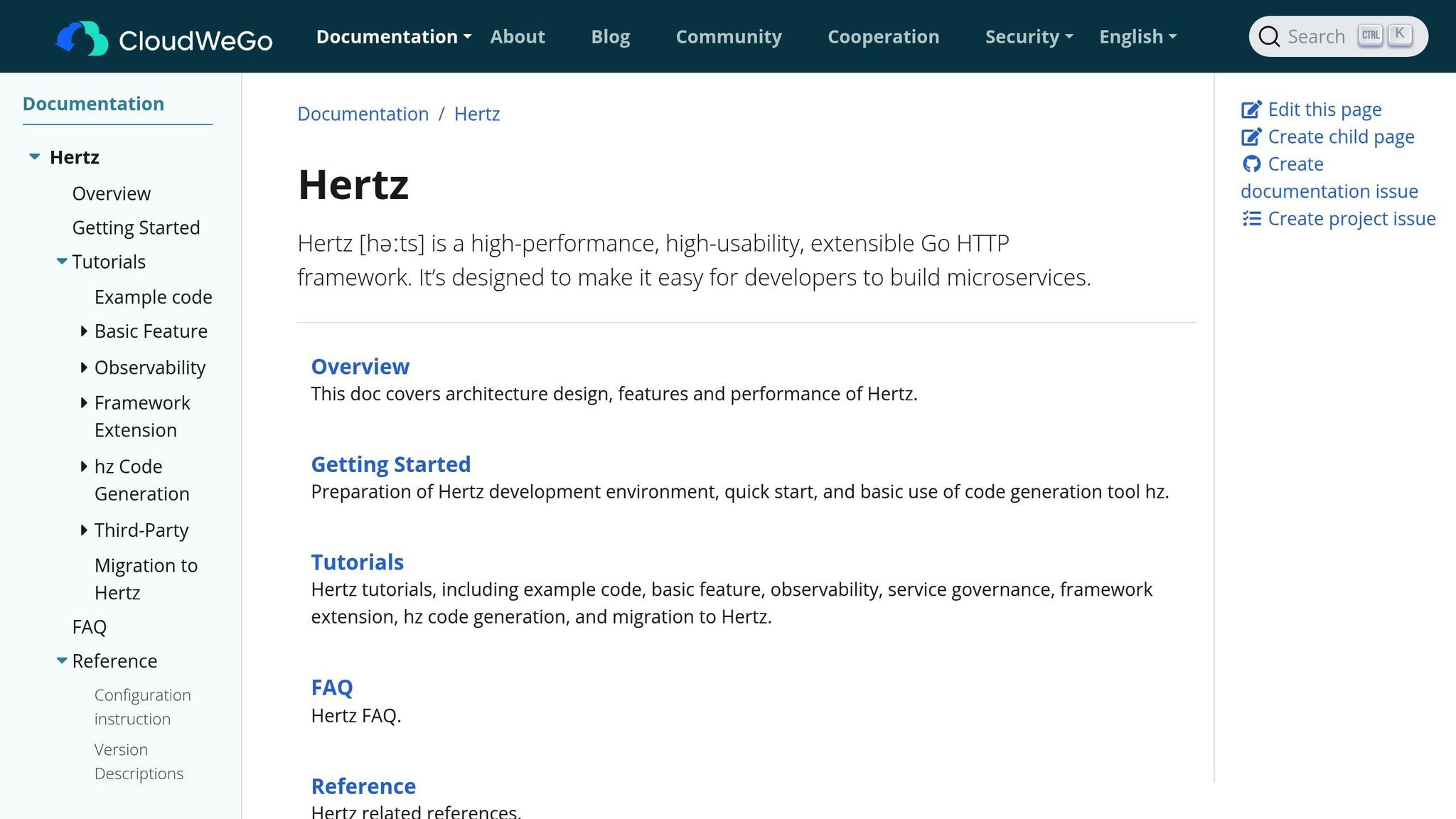
Hertz is a high-performance HTTP framework created by ByteDance as part of the CloudWeGo ecosystem. Drawing inspiration from popular frameworks like fasthttp, Gin, and Echo, Hertz incorporates its own performance tweaks to stand out in the Go ecosystem.
Performance and Speed#
At its core, Hertz prioritizes speed and efficiency. It employs Netpoll, a high-performance network library, as its default networking layer. This choice minimizes latency and boosts throughput compared to Go’s standard networking implementations. The routing engine is designed to handle thousands of requests per second with minimal overhead. Benchmarks consistently show Hertz outperforming the standard net package in both queries per second (QPS) and response times.
Middleware Support and Extensibility#
Hertz's layered architecture offers flexible interfaces and default extensions, making it easy for developers to customize solutions without losing compatibility. The Hertz-contrib repository hosts a variety of community-driven extensions that integrate seamlessly with the framework. Built-in middleware support includes tools for:
- CORS
- JWT authentication
- Gzip compression
- Internationalization
- Session management
- Profiling
- Security headers
- Error tracking
- Caching
This extensive middleware support ensures that developers can adapt Hertz to meet diverse project requirements.
Seamless Integration with the Go Ecosystem#
Hertz is designed to work well within the Go ecosystem. Developers can toggle between Netpoll and Go's standard net package, and additional plugins enhance networking capabilities. This flexibility makes it easier to integrate Hertz into existing Go projects while leveraging familiar tools. As part of the CloudWeGo ecosystem, Hertz also connects to a suite of tools and services tailored for cloud-native deployments, simplifying API development and scaling.
Best Fit for REST API Development#
Hertz shines in scenarios where high performance and low latency are essential. It’s particularly well-suited for cloud-native environments and real-time applications, such as:
- Gaming backends
- Financial trading platforms
- IoT data processing systems
Its ability to handle large volumes of simultaneous requests without sacrificing speed makes it a strong choice for microservices architectures. Organizations already using ByteDance infrastructure or those building enterprise-scale APIs will find Hertz especially valuable. Whether you're developing APIs for high-demand environments or scaling up to handle heavy traffic, Hertz delivers the performance and flexibility needed.
Next, we’ll take a look at Flamingo, a framework that leverages domain-driven design principles for API development.
10. Flamingo#
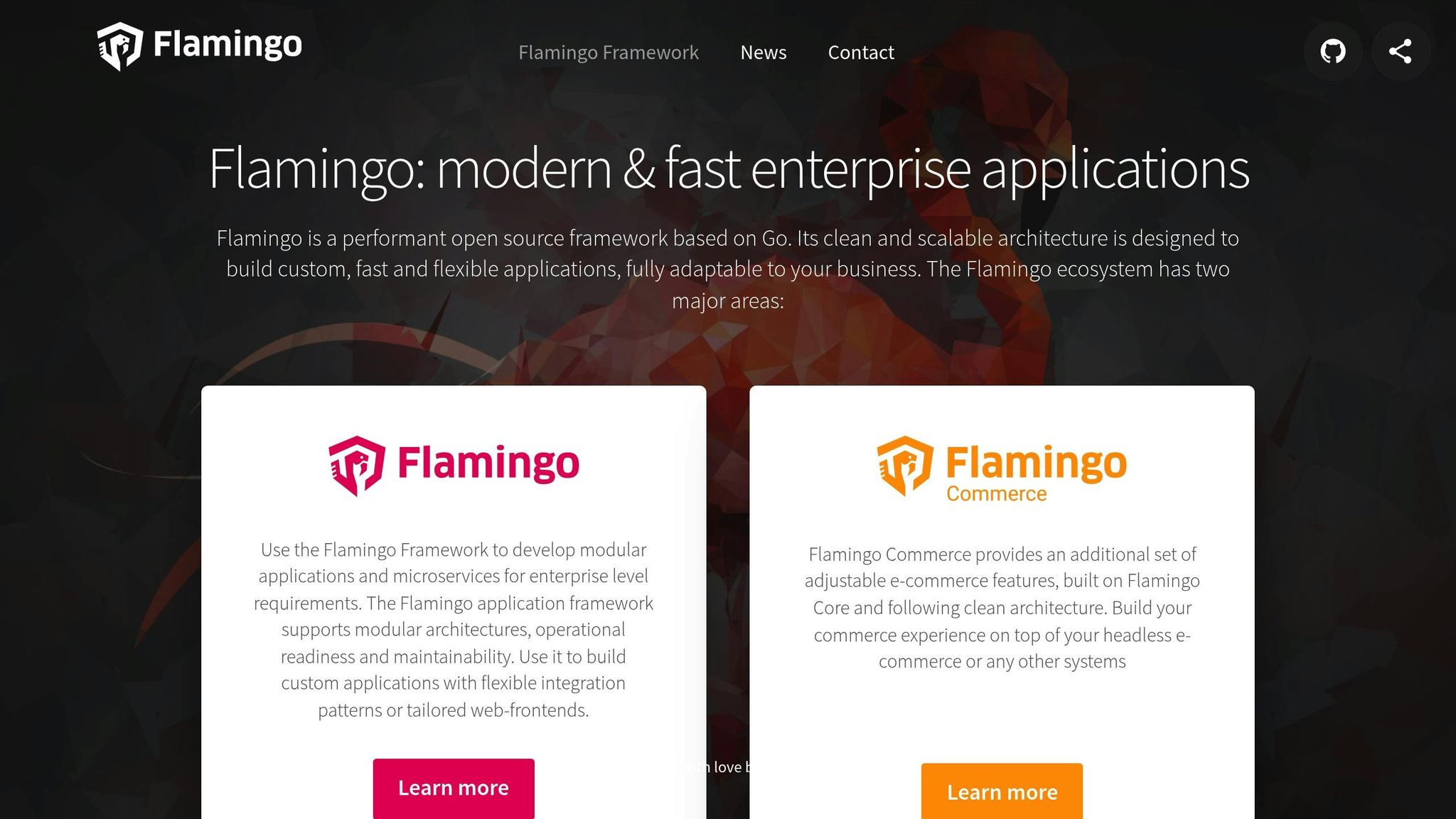
Flamingo wraps up our list as a powerful framework tailored for enterprise users, offering a full-stack solution designed to handle complex systems. Built with a modular architecture and domain-driven design principles, Flamingo is the successor to the Macaron framework. It’s specifically crafted for creating full-stack web applications and microservices that meet the demanding requirements of enterprise-level projects. Its recognition on GitHub further underscores its position as a standout framework in this space. Unlike lighter frameworks, Flamingo brings enterprise-grade capabilities to the table, making it an excellent choice for managing intricate API systems.
Middleware Support and Extensibility#
Flamingo’s core is lean but highly extensible, thanks to its robust middleware support. Developers can inject middleware flexibly, ensuring the code remains testable and easy to maintain. The framework also incorporates dependency injection directly into function signatures, which enhances code quality and simplifies customization without sacrificing architectural integrity.
Flamingo comes packed with essential features, including dependency injection, internationalization, template engines, GraphQL integration, observability tools, security middleware, event handling, and advanced routing. One standout feature is its flexible persistence layer, which allows developers to integrate other Go projects seamlessly instead of being tied to specific database solutions.
Seamless Integration with the Go Ecosystem#
Flamingo fits effortlessly into modern Go tech stacks. It follows Domain Driven Design principles and employs the Ports and Adapters pattern. This design enables frontend build pipelines to operate independently from backend logic, supporting both server-side template engines and GraphQL implementations. Such flexibility makes it easier to adapt Flamingo to various technology ecosystems.
The framework also includes OpenTelemetry integration right out of the box. This means developers can quickly implement application telemetry without extra configuration, simplifying the monitoring and maintenance of applications in production environments.
Best Fit for REST API Development#
Flamingo shines in enterprise settings where modular applications and microservices are crucial. It’s particularly effective for headless e-commerce platforms and microservice architectures that demand flexible integration patterns. Designed to thrive in modern production environments, Flamingo also provides built-in observability tools to ensure smooth operation.
Its efficient use of system resources and ability to leverage multi-core systems make Flamingo a great option for Backend for Frontend (BFF) implementations and custom applications requiring tailored web frontends.
"Flamingo is both an accelerator and force multiplier. It allows solutions to be spun up quickly while allowing developers to become proficient in a short period of time." – Daniel Pötzinger, CTO, AOE
Developers often highlight Flamingo’s ability to boost productivity quickly. Its combination of rapid onboarding, enterprise-level features, and a security-first approach makes it a strong contender for building REST APIs in demanding enterprise environments. With its modular and resource-efficient design, Flamingo is well-suited for tackling complex projects with ease.
Framework Comparison Table#
Each Go REST API framework has its own strengths, making it suitable for different scenarios. The table below provides a quick overview of ten popular frameworks, highlighting their key attributes to help developers choose the right one for their projects.
| Framework | Performance Level | Middleware Support | Integration Ease | Primary Use Cases |
|---|---|---|---|---|
| Gin | High (40x faster than Martini) | Comprehensive middleware support | Easy - large community | APIs, microservices, lightweight web apps |
| Echo | High performance, low memory | Comprehensive middleware support | Moderate - good documentation | Scalable APIs, performance-critical applications |
| Fiber | Very high (Express.js-like) | Rich middleware ecosystem | Easy migration from Node.js | High-performance APIs, microservices |
| Beego | Moderate (full-stack focus) | Built-in enterprise features | Complex due to feature richness | Full-stack web apps, enterprise applications |
| Chi | High (lightweight router) | Flexible middleware chaining | Simple integration | APIs, microservices, modular routing |
| FastHTTP | Extremely high | Custom middleware required | Difficult - low-level control | High-throughput APIs, custom web servers |
| Gorilla | Moderate (modular approach) | Powerful WebSocket support | High flexibility | Custom routing and web development |
| Buffalo | Moderate (full-stack) | Opinionated middleware stack | Simple but less flexible | Full-stack applications, rapid prototyping |
| Hertz | Extremely high | Microservice-focused middleware | Specialized integration | Microservices, high-concurrency systems |
| Flamingo | Moderate (enterprise-focused) | Enterprise-grade middleware | Complex due to DDD architecture | Enterprise applications, microservices |
Key Insights from the Comparison#
Performance is often a top priority when selecting a framework. For instance, FastHTTP stands out with its exceptional ability to handle high-throughput scenarios, making it ideal for traffic-heavy applications. Gin, on the other hand, combines strong performance with an active community, offering a balance between speed and ease of use. These performance advantages can directly influence user experience and infrastructure costs, especially for applications expecting significant traffic.
Ease of integration is another critical factor. Frameworks like Gin and Fiber are beginner-friendly, with straightforward learning curves and excellent community support. This makes them appealing for teams that prioritize rapid development and simplicity. On the flip side, enterprise-focused frameworks like Beego and Flamingo come with more built-in functionality but require a deeper understanding of their architecture. While they may take longer to master, they’re better suited for large-scale, feature-rich applications.
The choice ultimately hinges on your project’s specific needs. Lightweight frameworks like Chi and FastHTTP excel in microservice architectures, where modularity and performance are key. Meanwhile, full-stack options like Beego and Buffalo shine in scenarios requiring integrated tools and rapid prototyping. By balancing performance, development speed, and maintainability, you can pick the framework that aligns with your goals.
Conclusion#
Selecting the right Go REST API framework depends on your project's scope, your team’s expertise, and the performance requirements. As we've explored, each of the ten frameworks discussed brings its own strengths to the table. Whether it’s Gin for its blend of speed and simplicity, FastHTTP for unmatched throughput, Beego with its robust enterprise features, or Chi for its lightweight and modular design, the choice ultimately hinges on what aligns best with your specific needs.
"Simply put, choose the framework (or none) that is right for you or your team as there is no 'right' answer for everyone."
While Go's inherent speed is a given, other factors like community support, quality of documentation, and ease of maintenance are equally crucial. A practical approach is to start by building a simple CRUD API using two frameworks. This hands-on method helps you evaluate aspects like scalability, middleware support, and integration ease.
Another option is to begin with Go’s standard library and a basic router before transitioning to a full-fledged framework. This foundational approach not only strengthens your understanding of Go but also ensures you make more informed decisions down the line. Remember, the framework you choose can significantly influence your project's trajectory, so taking the time to thoroughly test and evaluate options is a worthwhile investment.
The Go ecosystem offers a variety of excellent frameworks to suit virtually any project. With these insights, you're well-prepared to select the framework that best fits your REST API development goals.
FAQs#
What should I look for when selecting a Go REST API framework for my project?#
When selecting a Go REST API framework, prioritize performance and scalability - especially if your application is expected to handle heavy traffic or grow over time. The framework you choose should efficiently manage concurrent requests and be optimized for speed to ensure smooth operation.
It's also important to evaluate the framework's stability and popularity within the Go developer community. Established frameworks with active maintenance and strong community backing tend to be more dependable for long-term projects. Plus, widely-used options often come with detailed documentation and a wealth of troubleshooting resources, making development smoother.
Finally, make sure the framework aligns with REST principles like statelessness, cacheability, and a uniform interface. These principles are the foundation of well-designed APIs, ensuring they are robust and easy to maintain. Keeping these factors in mind will help you pick a framework that fits your project's specific requirements.
How do the top Go REST API frameworks differ in performance, and why does it matter?#
The way Go REST API frameworks perform can vary significantly, depending on their design priorities. For instance, FastHTTP is all about raw speed and high throughput, making it a strong choice for applications that demand top-tier performance. On the other hand, frameworks like Fiber and Echo aim to balance speed, resource efficiency, and additional features, which makes them excellent options for scalable and responsive APIs.
Why does this matter? Because a framework's performance directly impacts how well your API can handle heavy traffic, deliver quick responses, and optimize resource usage. Selecting the right framework is key to ensuring your application meets user demands, especially when dealing with high-traffic environments or limited resources.
What are the main benefits of using a full-stack Go framework like Beego or Buffalo compared to lightweight options like Gin or Chi?#
Full-stack frameworks like Beego and Buffalo offer a complete package for developers, bundling features like routing, middleware, ORM, and templating into one cohesive system. They simplify the process of building complex, scalable applications by handling many of the heavy lifting tasks, making development faster and more efficient.
On the other hand, lightweight frameworks such as Gin and Chi focus on speed and simplicity. These frameworks are perfect for creating high-performance APIs or microservices, giving developers more control and keeping resource usage low. Deciding between these options comes down to your project requirements - full-stack frameworks shine in large, feature-rich projects, while lightweight ones are ideal for performance-driven, modular applications.